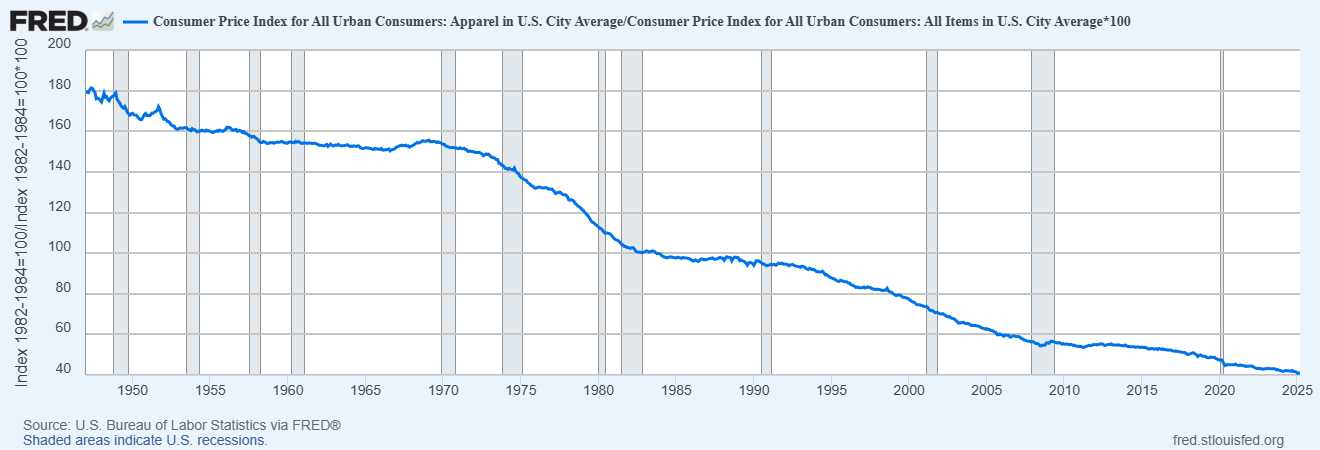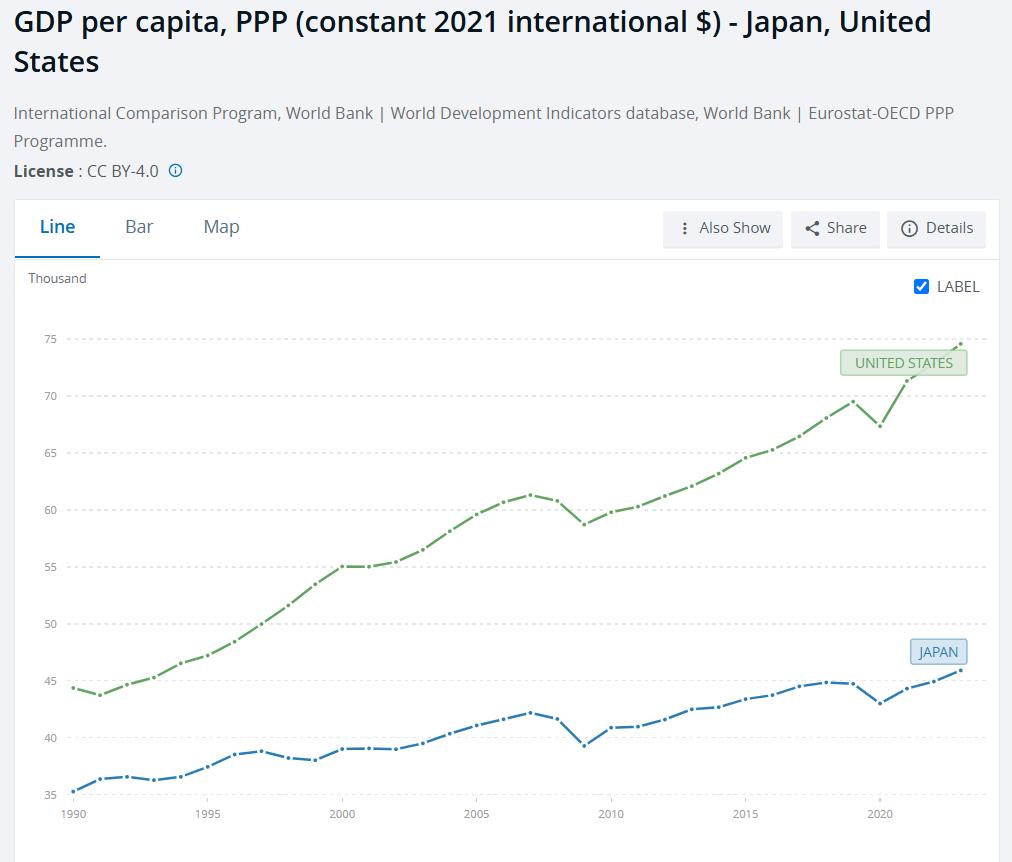The Office of the U.S. Trade Representative (USTR) recently tweeted that they wanted to bring back apparel manufacturing to the United States. Why would anyone want more jobs with long hours and low pay, whether historically in the US or currently in places like Bangladesh? Thanks in part to international trade, the real price of clothing has fallen dramatically (see figure below). Clothing expenditure dropped from 9-10% of household budgets in the 1960s (down from 14% in 1900) to about 3% today.

Apparently, however, not everyone agrees. While some responses to my tweet revealed misunderstandings of basic economics, one interesting counter-claim emerged–the low price of imported clothing has been a false bargain, the argument goes, because the quality of clothing has fallen.
The idea that clothing has fallen in quality is very common (although it’s worth noting that this complaint was also made more than 50 years ago, suggesting a nostalgia bias, like the fact that the kids today are always going to hell). But are there reliable statistics documenting a decline in quality? In some cases, there are! For example, jeans from the 1960s-80s, for example, were often 13–16 oz denim, compared to 9–11 oz today. According to some sources, the average garment life is down modestly. The statistical evidence is not great but the anecdotes are widespread and I shall accept them. Most sources date the decline in quality to the fast fashion trend which took off in the 1990s and that provides a clue to what is really going on.
Fast fashion, led by firms like Zara, is a business model that focuses on rapidly transforming street style and runway trends into mass-produced, low-cost clothing—sometimes from runway to store within weeks. The model is not about timeless style but about synchronized consumption: aligning production with ephemeral cultural signals, i.e. to be fashionable, which is to say to be on trend, au-courant and of the moment.
It doesn’t make sense to criticize fast fashion for lacking durability—by design, it isn’t meant to last. Making it durable would actually be wasteful. The product isn’t just clothing; it’s fashionable clothing. And in that sense, quality has improved: fast fashion is better than ever at delivering what’s current. Critics who lament declining quality miss the point—it’s fun to buy new clothes and if consumers want to buy new clothes it doesn’t make sense to produce long lasting clothes. People do own many more pieces of clothing today than in the past but the flow is the fun.
So my argument is that the decline in “quality” clothing has little to do with the shift to importing but instead is consumer-driven and better understood as an increase in the quality of fashion. Testing my theory isn’t hard. Consider clothing where function, not just fashion, is paramount: performance sportswear and Personal Protective Equipment (PPE).
There has been a massive and obvious improvement in functional clothing. The latest GoreTex jackets, for example, are more than five times as water resistant (28 000 mm hydrostatic head) compared to the best waxed cotton technology of the past (~5 000 mm) and they are breathable (!) and lighter. Or consider PolarTec winter jackets, originally developed for the military these jackets have the incredible property of releasing heat when you are active but holding it in when you are inactive. (In the past, mountain climbers and workers in extreme environments had to strip on or off layers to prevent over-heating or freezing while exerting effort or resting.) Amazing new super shoes can actually help runners to run faster! Now that is high quality. Personal protective equipment has also increased in quality dramatically. Industrial workers and intense sports enthusiasts can now wear impact resistant gloves which use non-Newtonian polymers that stiffen on impact to reduce hand injuries.
 Moreover, it’s not just functional clothing that has increased in quality. For those willing to look, there is in fact plenty of high-quality clothing readily available. From Iron Heart, for example, you can buy jeans made with 21oz selvedge indigo denim produced in Japan. Pair with a high-quality Ralph Lauren shirt, a Mackinaw Wool Cruiser Jacket and a nice pair of Alden boots. Experts like the excellent Derek Guy regularly highlight such high-quality options. Of course, when Derek Guy discusses clothes like this people complain about the price and accuse him of being an elitist snob. Sigh. Tradeoffs are everywhere.
Moreover, it’s not just functional clothing that has increased in quality. For those willing to look, there is in fact plenty of high-quality clothing readily available. From Iron Heart, for example, you can buy jeans made with 21oz selvedge indigo denim produced in Japan. Pair with a high-quality Ralph Lauren shirt, a Mackinaw Wool Cruiser Jacket and a nice pair of Alden boots. Experts like the excellent Derek Guy regularly highlight such high-quality options. Of course, when Derek Guy discusses clothes like this people complain about the price and accuse him of being an elitist snob. Sigh. Tradeoffs are everywhere.
Critics long for a past when goods were cheap, high quality, and Made in America—but that era never really existed. Clothing in the past was more expensive and often low quality. To the extent that some products in the past were of higher quality–heavier fabric jeans, for example–that was often because the producers of the time couldn’t produce it less expensively. Technology and trade have increased variety along many dimensions, including quality. As with fast fashion, lower quality on some dimensions can often produce a superior product. And, of course, it should be obvious but it needs saying: products made abroad can be just as good—or better—than those made domestically. Where something is made tells you little about how well it’s made.
The bottom line is that international trade has brought us more options and if today’s household were to redirect the historical 9 – 10 % share of income to clothing, it could absolutely buy garments that are heavier, better-constructed, and longer-lived than the typical mid-century mass-market clothing.
The post Has Clothing Declined in Quality? appeared first on Marginal REVOLUTION.







